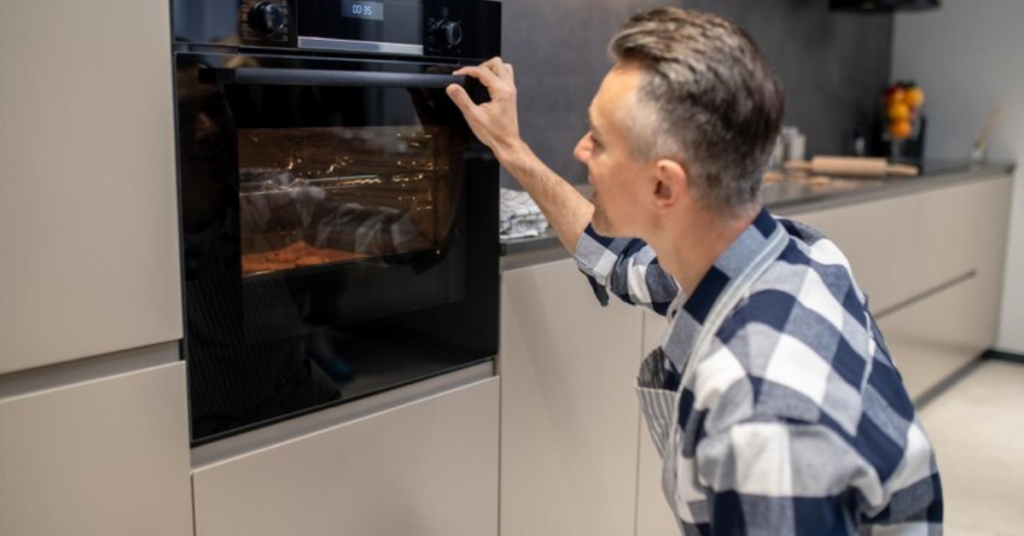In the modern kitchen efficiency and aesthetics go hand in hand. With the evolution of kitchen appliances one key player has undergone a significant transformation—the microwave oven. Built in microwaves have become a popular choice for homeowners looking to streamline their kitchens combining functionality with a seamless design.
The Evolution of Microwaves
Since mid-20th century, microwaves transformed from bulky standalone units emphasizing function over aesthetics to today’s sleek, efficient designs. As kitchen design trends favored integration and a streamlined appearance, the demand for built-in microwaves emerged, aligning with contemporary preferences.
Built-in microwaves are designed to seamlessly integrate with the cabinetry providing a sleek and cohesive appearance. Integrated microwaves not only save counter space but also enhance the kitchen’s overall aesthetic appeal, combining functionality with style. The evolution of microwaves reflects a broader trend in kitchen design—melding practicality with style.
Benefits of Built-In Microwaves
Space Efficiency
Built-in microwaves are installed within cabinetry or wall units freeing up valuable counter space. This is particularly advantageous for smaller kitchens where every square inch counts. By eliminating the need for a standalone microwave on the countertop you create a cleaner and more organized cooking area.
Seamless Design
One of the primary attractions of built-in microwaves is their ability to seamlessly blend into the kitchen design. They can be customized to match cabinets providing a cohesive and integrated look. This aesthetic enhancement contributes to a more polished and sophisticated kitchen space.
Improved Ventilation
Many built in microwaves come with built-in ventilation systems that efficiently remove smoke and odors. This feature is especially beneficial for kitchens without a dedicated range hood. Improved ventilation enhances kitchen air, creating a more comfortable cooking environment and contributing to an overall pleasant culinary experience.
Increased Property Value
Investing in built-in appliances including microwaves can increase the resale value of your home. Buyers value well-designed kitchens for convenience and aesthetics, making it a worthwhile investment for homeowners planning future sales.
Considerations When Choosing a Built-In Microwave
Size and Capacity
Built-in microwaves come in various sizes and capacities. Consider your cooking needs and available space when choosing a model. Ensure that the microwave you select fits seamlessly into the designated cabinet space without compromising on performance.
Venting Options
Ventilation is a crucial aspect of microwave functionality. Some built in microwaves come with recirculating vents while others offer external venting options. The choice depends on your kitchen’s layout and whether you can connect the microwave to an external ventilation system.
Power and Features
Assess the power and features offered by different models. Wattage determines cooking speed, so opt for a microwave with sufficient power for your cooking requirements. Additionally, consider features such as sensor cooking, convection capabilities, and programmable settings to enhance versatility.
Aesthetic Harmony
The success of a built-in microwave lies in its ability to complement your kitchen’s aesthetic. Choose a model that matches your cabinetry in terms of color, finish, and style. This ensures a cohesive look that seamlessly integrates the microwave into the overall design scheme.
Installation Tips for Built-In Microwaves
Professional Installation
While some homeowners may opt for a DIY approach, professional installation is recommended for built-in microwaves. This ensures proper placement, ventilation, and electrical connections. Professional installers have the expertise to seamlessly integrate the microwave into your cabinetry, creating a polished and secure fit.
Electrical Considerations
Verify that the chosen location for your built-in microwave has the necessary electrical outlets. Ensure that the electrical requirements of the microwave align with your kitchen’s wiring capacity. It’s crucial to comply with safety standards and regulations during the installation process.
Ventilation Planning
Consider the ventilation requirements of your built-in microwave. If possible connect the microwave to an external ventilation system for optimal performance. If external venting is not feasible choose a model with efficient recirculating vents to maintain air quality in the kitchen.
Cabinet Modifications
Depending on the chosen microwave model you may need to make modifications to your cabinetry to accommodate the appliance. Consult with a professional installer to assess and make any necessary adjustments to ensure a seamless and secure fit.
Maintenance and Care
Regular Cleaning
Maintain the pristine appearance of your built-in microwave by cleaning it regularly. Wipe down the interior and exterior surfaces with a mild cleaning solution. Pay attention to the control panel, door and ventilation grilles to prevent the buildup of dirt and grease.
Air Vent Maintenance
Keep the ventilation system in optimal condition by regularly cleaning and replacing filters. This ensures efficient airflow and prevents the accumulation of dust and debris.
Refer to the manufacturer’s guidelines for specific maintenance instructions related to your microwave model.
Safety Checks
Periodically inspect the electrical connections and ensure that the microwave is functioning safely. If you notice any issues such as unusual sounds, sparks, or a malfunctioning control panel, seek professional assistance promptly. Regular safety checks contribute to the longevity and reliability of your built-in microwave.
FAQs
Q1: What are the key benefits of integrating a built-in microwave into my kitchen?
A: Built-in microwaves offer a seamless and space-saving solution, enhancing the aesthetics of your kitchen while providing convenient access to cooking essentials. They blend effortlessly with cabinetry, creating a streamlined and cohesive look.
Q2: How do built-in microwaves differ from countertop models, and what advantages do they bring?
A: Built-in microwaves are designed to fit seamlessly within cabinetry or wall units, saving valuable counter space. Unlike countertop models, they offer a customized appearance and are ideal for those seeking a more integrated and organized kitchen layout.
Q3: Are there specific considerations for installation when opting for a built-in microwave?
A: Installation considerations include precise measurements, ensuring compatibility with existing cabinetry, and selecting an appropriate power source. Ventilation requirements should also be addressed to optimize performance and maintain the overall functionality of the built-in microwave.
Q4: What features should I look for when choosing a built-in microwave for my kitchen?
A: When selecting a built-in microwave, consider features such as power levels, cooking modes, sensor technology, and ease of use. Look for models that complement your cooking habits and lifestyle, providing a combination of efficiency and versatility.
Q5: Can a built-in microwave be retrofitted into an existing kitchen, or is it more suitable for new construction or remodels?
A: Built-in microwaves are versatile and can be integrated into existing kitchens during renovations or as part of new construction. Retrofitting may require adjustments to cabinetry, but with careful planning and professional installation, it’s possible to enhance the functionality and appearance of your kitchen with a built-in microwave.
Conclusion
Streamlining your kitchen with a built-in microwave is a transformative step towards achieving a harmonious balance between functionality and aesthetics. Microwave technology evolution yields appliances with practicality and design synergy, enhancing the kitchen space’s overall aesthetic and functionality.
Embracing space efficiency, seamless design, improved ventilation, and increased property value informs homeowners’ choices when selecting and installing a built-in microwave. Size, venting options, power, and aesthetic harmony are crucial considerations to ensure the chosen microwave aligns with cooking needs and design preferences.”
The installation process guided by professional expertise ensures a secure and integrated fit within your cabinetry. Regular maintenance and care are crucial to preserve the built-in microwave’s appearance and functionality, ensuring longevity and optimal performance.
The ultimate guide to built in microwaves serves as a valuable resource for homeowners seeking to enhance their kitchen space. As kitchens evolve into multifunctional hubs, integrating appliances like built-in microwaves reflects a commitment to practicality and style, creating an efficient and joyful space.






